The Effect of Torsional Vibration in Longitudinal–Torsional Coupled Ultrasonic Vibration-Assisted Grinding of Silicon Carbide Ceramics
Abstract
1. Introduction
2. Kinematic Analysis of LUAG and LTUAG
3. Experimental Details
4. Measurement Method of Actual Amplitude
5. Results and Discussion
5.1. Grinding Force of LTUAG and LUAG
5.2. Surface Roughness of LTUAG and LUAG
6. Conclusions
- (1)
- A new method for measuring the amplitude ratio of torsional to longitudinal vibration by using a PSV laser doppler sensor and a square tool is proposed in this study. The longitudinal–torsional coupled vibration ultrasonic transducer has eight spiral grooves, with each spiral groove measuring 10 mm long by 1 mm wide and 2 mm deep. The spiral groove has a helix angle of 45 degrees, and the amplitude ratio is 0.472.
- (2)
- A method for the real-time measurement of the AA during grinding is proposed. This method can be free from the interferences and influences of external factors, such as tool rotation and cutting fluid. With the experimental setup, the experiments show that the proposed method is effective for AA measurement, and can ensure the consistency of the longitudinal amplitude of LTUAG and LUAG.
- (3)
- When the longitudinal amplitudes of LTUAG and LUAG are the same, the torsional vibration of LTUAG will not increase the trajectory length of the single abrasive. However, the torsional vibration can increase the grinding speed of LTUAG, which reduces the undeformed chip thickness of LTUAG, and the grinding force of LTUAG is smaller than that of LUAG.
- (4)
- Accompanied by a reduction in the undeformed chip thickness, the surface roughness of LTUAG has been effectively improved. Compared with LUAG, the roughness of LTUAG reduced by 1.36 to 9.97%. With the increase in grinding speed and feed speed, the roughness of LTUAG approached the roughness produced by LUAG because the grinding speed of LTUAG was close to that of LUAG.
Author Contributions
Funding
Data Availability Statement
Acknowledgments
Conflicts of Interest
Nomenclature
| LUAG | longitudinal ultrasonic vibration-assisted grinding |
| LTUAG | longitudinal–torsional coupled ultrasonic vibration-assisted grinding |
| CG | conventional grinding |
| vs | grinding speed, m/s |
| vw | feed speed, mm/min |
| ap | grinding depth of cut, μm |
| ae | axial depth of cut, mm |
| AL | amplitude of longitudinal vibration, μm |
| AT | amplitude of torsional vibration, μm |
| f | frequency of the ultrasonic tool holder, kHz |
| R | radius of the tool, mm |
| n | rotating speed of the tool, rpm |
| η | amplitude-to-voltage ratio, μm/v |
| U | output voltage of the eddy current sensor, v |
| θ | torsional angle, rad |
| φ | phase difference between longitudinal vibration and torsional vibration, rad |
| augmax | maximum undeformed chip thickness, μm |
| vmax | maximum grinding speed of LTUAG, m/s |
| vmin | minimum grinding speed of LTUAG, m/s |
| Kf | reduction rate of the grinding force produced by LTUAG compared to the grinding force produced by LUAG |
| M | reduction rate of the surface roughness produced by LTUAG compared to the surface roughness produced by LUAG |
References
- Ding, K.; Fu, Y.; Su, H.; Gong, X.; Wu, K. Wear of diamond grinding wheel in ultrasonic vibration-assisted grinding of silicon carbide. Int. J. Adv. Manuf. Technol. 2014, 71, 1929–1938. [Google Scholar] [CrossRef]
- Wang, J.; Feng, P.; Zhang, J.; Guo, P. Experimental study on vibration stability in rotary ultrasonic machining of ceramic matrix composites: Cutting force variation at hole entrance. Ceram. Int. 2018, 44, 14386–14392. [Google Scholar] [CrossRef]
- Ding, K.; Fu, Y.; Su, H.; Chen, Y.; Yu, X.; Ding, G. Experimental studies on drilling tool load and machining quality of C/SiC composites in rotary ultrasonic machining. J. Mater. Process. Technol. 2014, 214, 2900–2907. [Google Scholar] [CrossRef]
- Zhang, C.; Cong, W.; Feng, P.; Pei, Z. Rotary ultrasonic machining of optical K9 glass using compressed air as coolant: A feasibility study. Proc. Inst. Mech. Eng. B J. Eng. 2013, 228, 504–514. [Google Scholar] [CrossRef]
- Lv, D.; Zhang, Y.; Peng, Y. High-frequency vibration effects on hole entrance chipping in rotary ultrasonic drilling of BK7 glass. Ultrasonics 2016, 72, 47–56. [Google Scholar] [CrossRef] [PubMed]
- Mult, H.C.; Spur, G.; Holl, S.-E. Ultrasonic assisted grinding of ceramics. J. Mater. Process. Technol. 1996, 62, 287–293. [Google Scholar]
- Zhang, J.; Zhao, Y.; Zhang, S.; Tian, F.; Guo, L.; Dai, R. Study on effect of ultrasonic vibration on grinding force and surface quality in ultrasonic assisted micro end grinding of silica glass. Shock Vib. 2014, 2014, 418059. [Google Scholar]
- Tesfay, S.; Xu, Z.; Li, Z. Ultrasonic vibration assisted grinding of bio-ceramic materials: An experimental study on edge chippings with Hertzian indentation tests. Int. J. Adv. Manuf. Tech. 2016, 86, 3483–3494. [Google Scholar] [CrossRef]
- Zahedi, A.; Tawakoli, T.; Akbari, J. Energy aspects and workpiece surface characteristics in ultrasonic-assisted cylindrical grinding of alumina-zirconia ceramics. Int. J. Mach. Tools Manu. 2015, 90, 16–28. [Google Scholar] [CrossRef]
- Jain, A.; Pandey, P. Modeling of un-deformed chip thickness in RUM process and study of size effects in μ-RUM. Ultrasonics 2017, 77, 1–16. [Google Scholar] [CrossRef]
- Gong, H.; Fang, F.; Hu, X. Kinematic view of tool life in rotary ultrasonic side milling of hard and brittle materials. Int. J. Mach. Tools Manuf. 2010, 50, 303–307. [Google Scholar] [CrossRef]
- Bai, D.; Quan, Q.; Wang, Y.; Tang, D.; Deng, Z. A longitudinal & longitudinal-torsional vibration actuator for rotary-percussive ultrasonic planetary drills. Adv. Space Res. 2019, 63, 1065–1072. [Google Scholar]
- Wang, J.; Feng, P.; Zhang, J.; Guo, P. Reducing cutting force in rotary ultrasonic drilling of ceramic matrix composites with longitudinal-torsional coupled vibration. Manuf. Lett. 2018, 18, 1–5. [Google Scholar]
- Yang, C.; Shan, X.; Xie, T. A new piezoelectric ceramic longitudinal-torsional composite ultrasonic vibrator for wire drawing. Ceram. Int. 2015, 41, S625–S630. [Google Scholar]
- Asami, T.; Miura, H. Study of ultrasonic machining by longitudinal-torsional vibration for processing brittle materials-observation of machining marks. Phys. Procedia 2015, 70, 118–121. [Google Scholar] [CrossRef]
- Amini, S.; Soleimani, M.; Paktinat, H.; Lotfi, M. Effect of longitudinal—Torsional vibration in ultrasonic-assisted drilling. Mater. Manuf. Process. 2017, 32, 616–622. [Google Scholar] [CrossRef]
- Chen, P.; Tong, J.; Zhao, J.; Zhang, Z.; Zhao, B. A study ofthe surface microstructure and tool wear of titanium alloys after ultrasonic longitudinal-torsional milling. J. Manuf. Process. 2020, 53, 1–11. [Google Scholar] [CrossRef]
- Cao, J.; Wu, Y.; Li, J.; Zhang, Q. A grinding force model for ultrasonic assisted internal grinding (UAIG) of SiC ceramics. Int. J. Adv. Manuf. Technol. 2015, 81, 875–885. [Google Scholar] [CrossRef]
- Li, C.; Zhang, F.; Meng, B.; Liu, L.; Rao, X. Material removal mechanism and grinding force modelling of ultrasonic vibration assisted grinding for SiC ceramics. Ceram. Int. 2017, 43, 2981–2993. [Google Scholar] [CrossRef]
- Xiao, X.; Zheng, K.; Liao, W.; Meng, H. Study on cutting force model in ultrasonic vibration assisted side grinding of zirconia ceramics. Int. J. Mach. Tools Manuf. 2016, 104, 58–67. [Google Scholar]
- Liang, Y.; Chen, Y.; Chen, B.; Fan, B.; Yan, C.; Fu, Y. Feasibility of Ultrasonic Vibration Assisted Grinding for Carbon Fiber Reinforced Polymer with Monolayer Brazed Grinding Tools. Int. J. Precis. Eng. Manuf. 2019, 20, 1083–1094. [Google Scholar] [CrossRef]
- Wang, J.; Feng, P.; Zhang, J. Reducing edge chipping defect in rotary ultrasonic machining of optical glass by compound step-taper tool. J. Manuf. Process. 2018, 32, 213–221. [Google Scholar] [CrossRef]
- Wang, Y.; Lin, B.; Cao, X.; Wang, S. An experimental investigation of system matching in ultrasonic vibration assisted grinding for titanium. J. Mater. Process. Technol. 2014, 214, 1871–1878. [Google Scholar] [CrossRef]
- Wen, Y.; Tang, J.; Zhou, W.; Zhu, C. Study on contact performance of ultrasonic-assisted grinding surface. Ultrasonics 2019, 91, 193–200. [Google Scholar] [CrossRef]
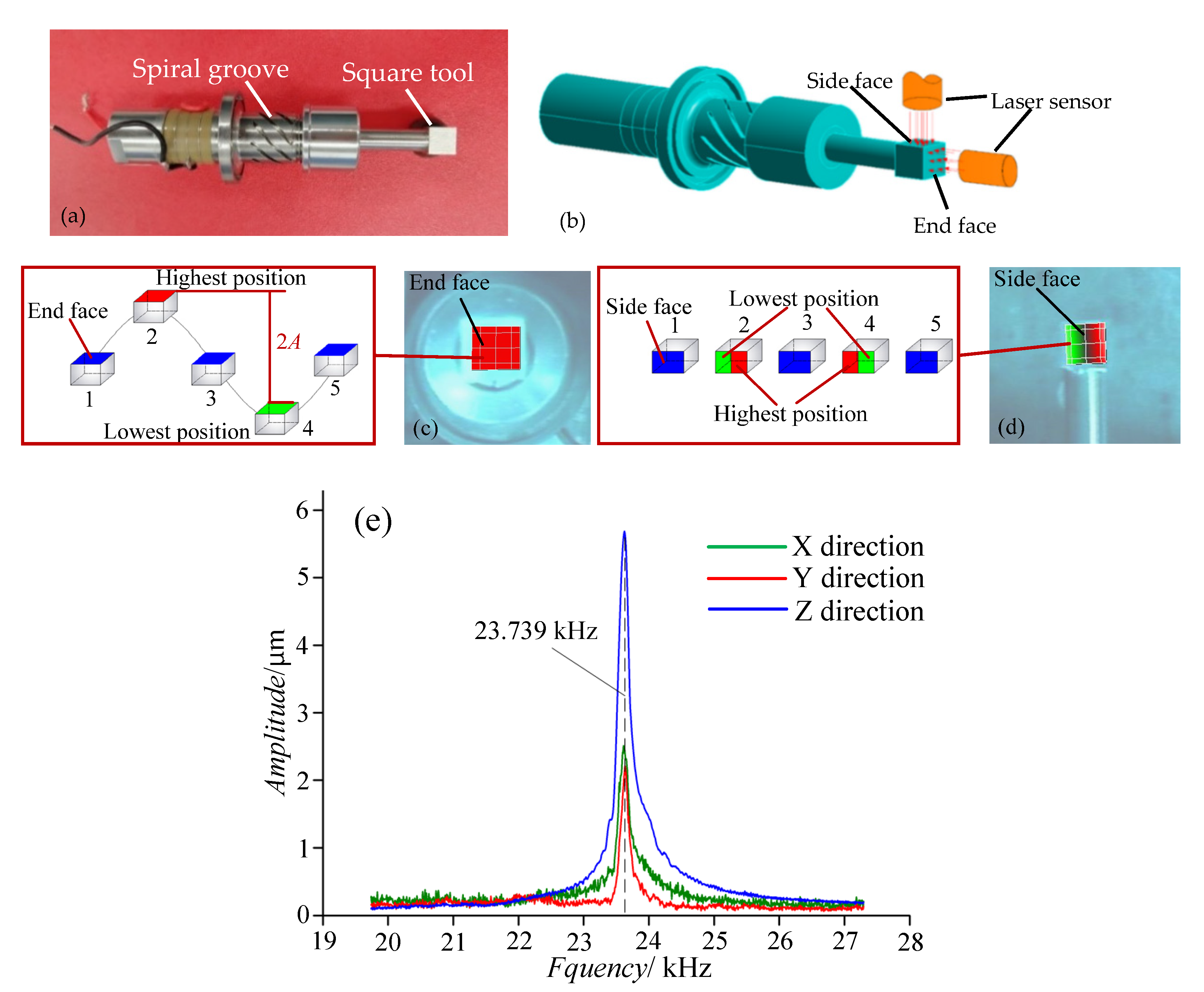
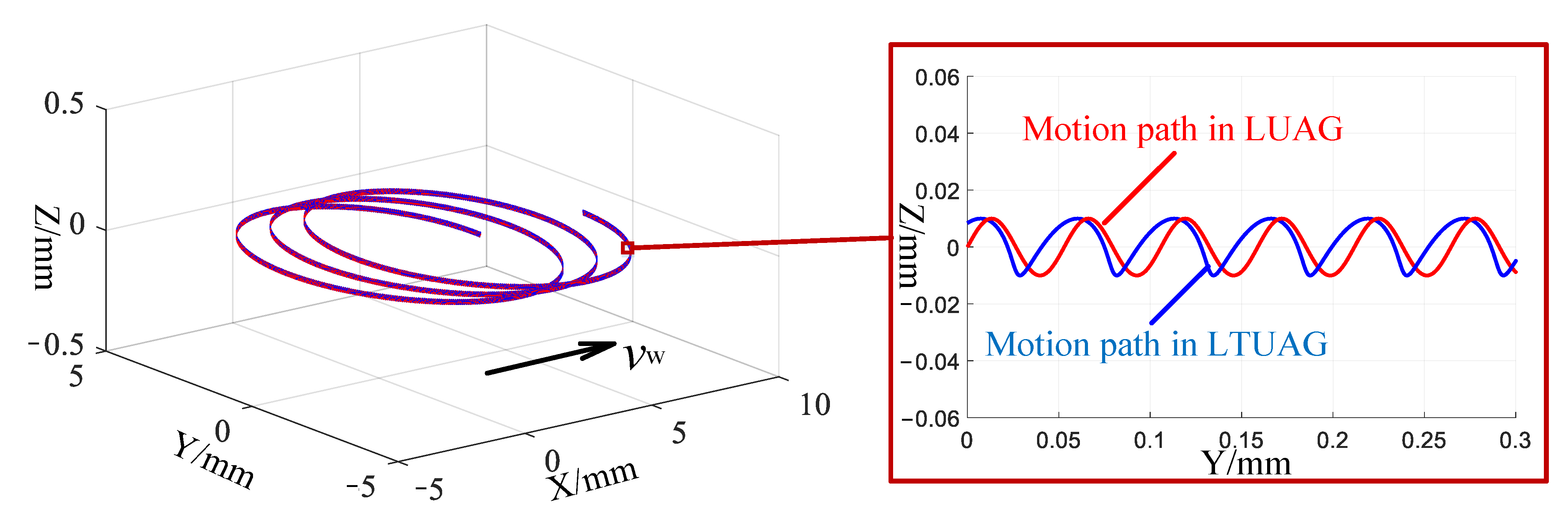
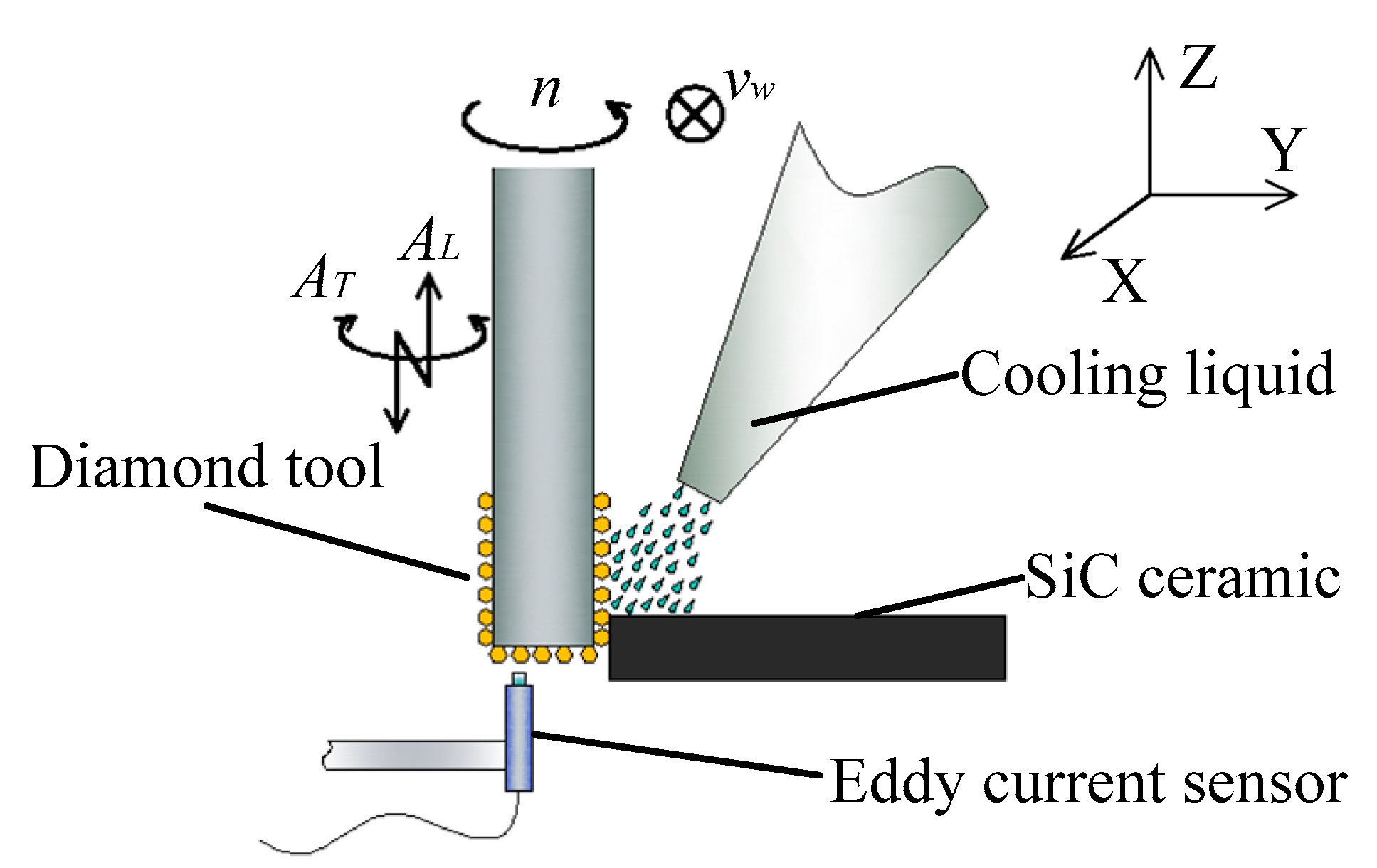
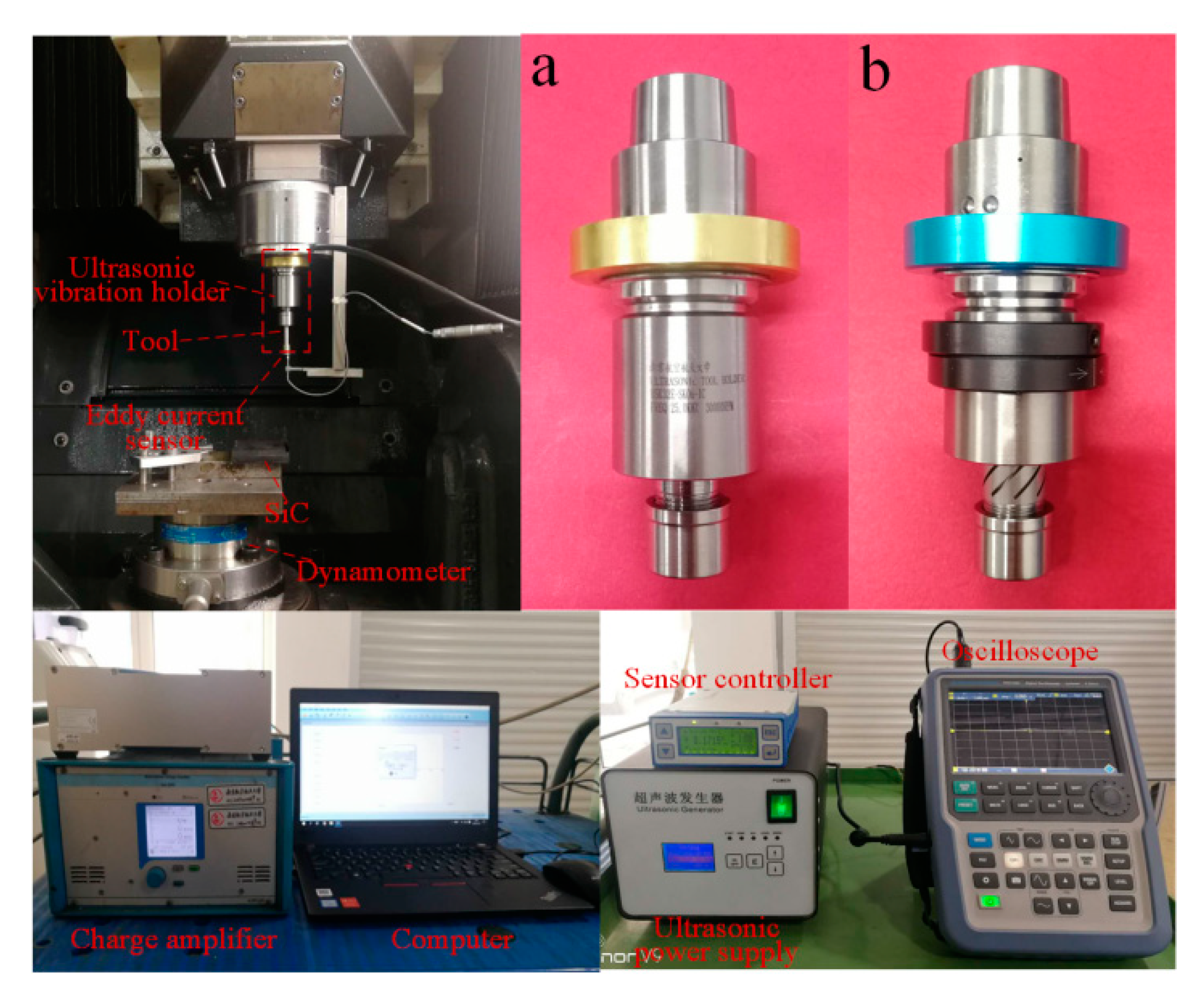
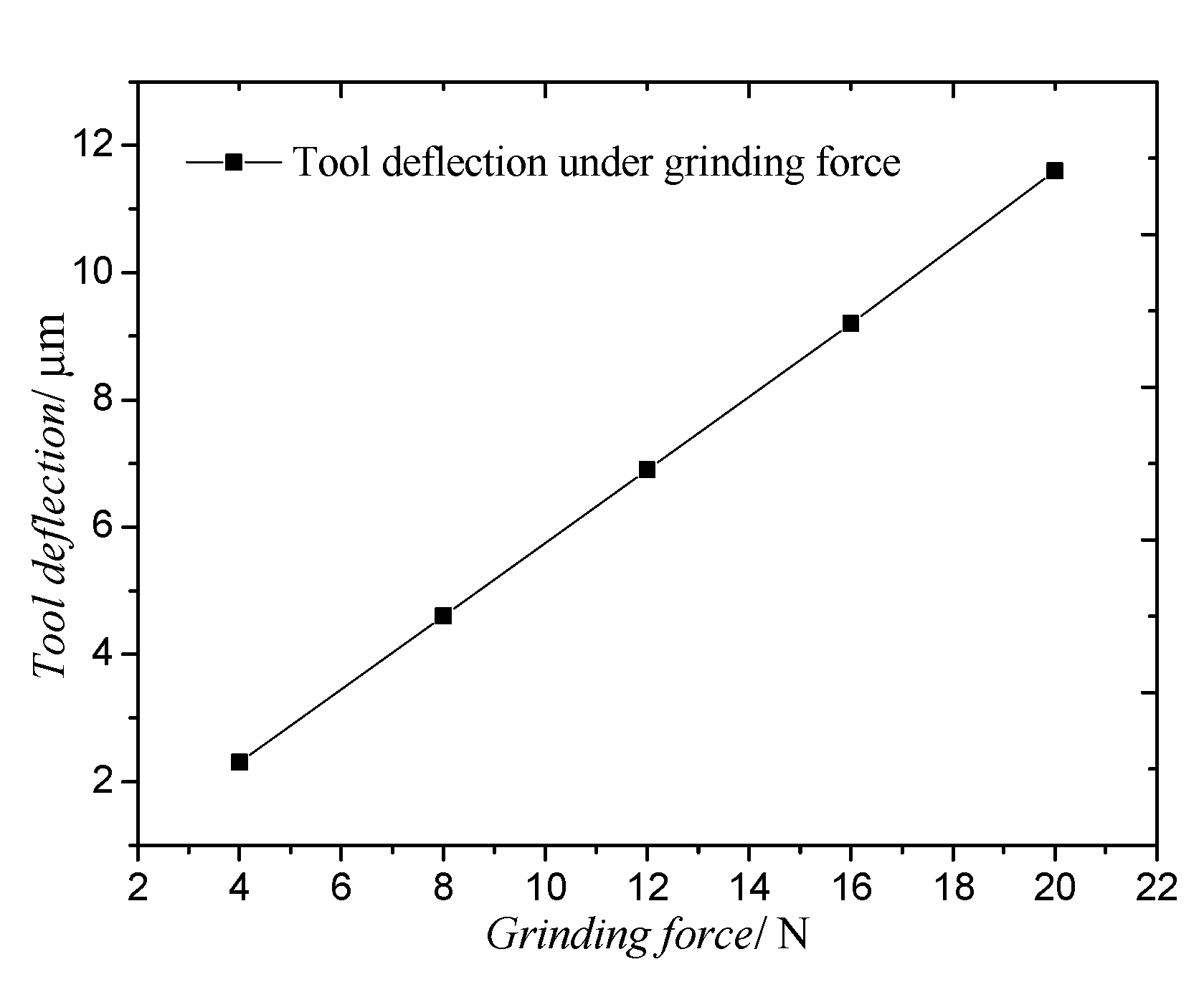
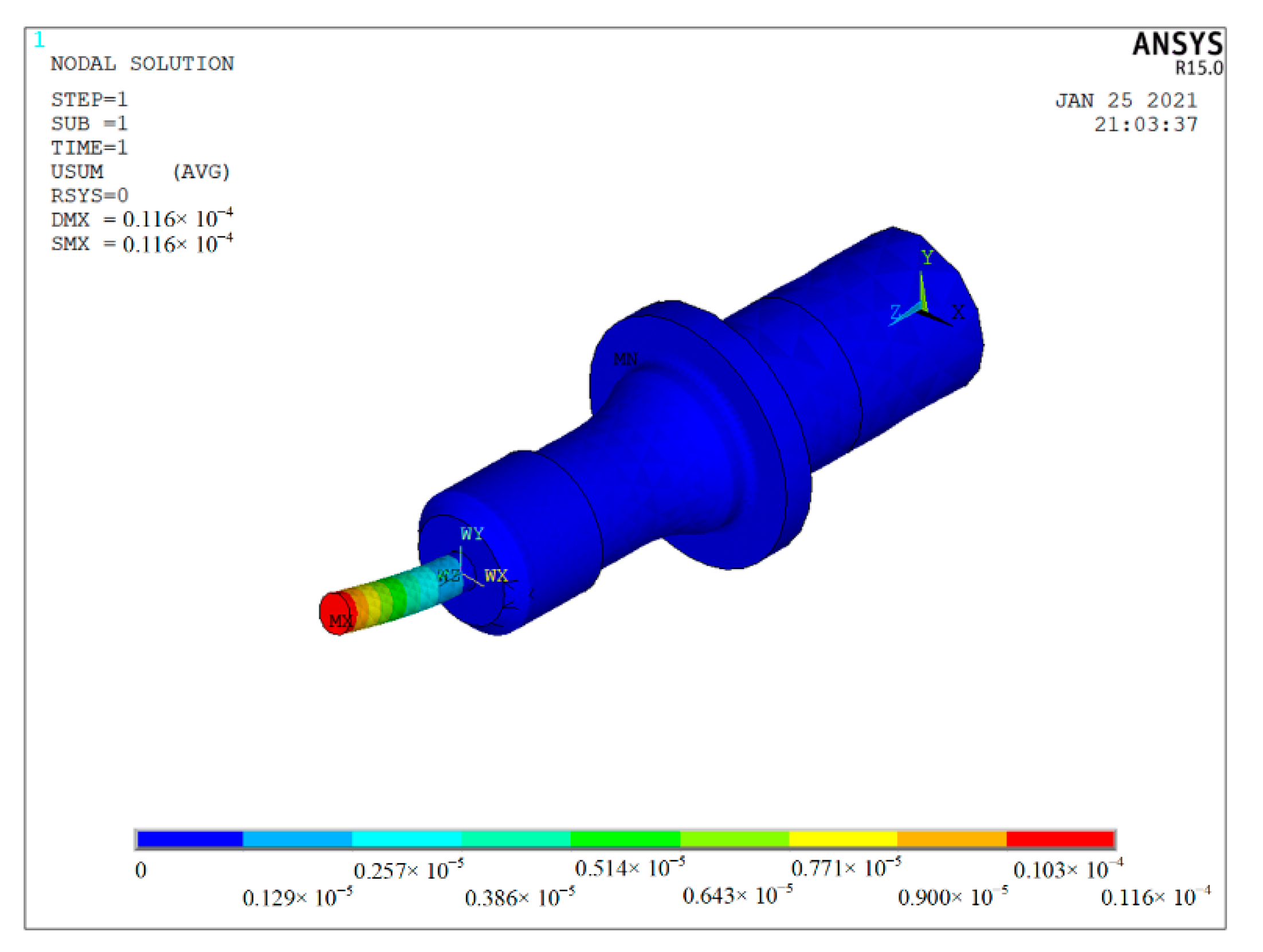
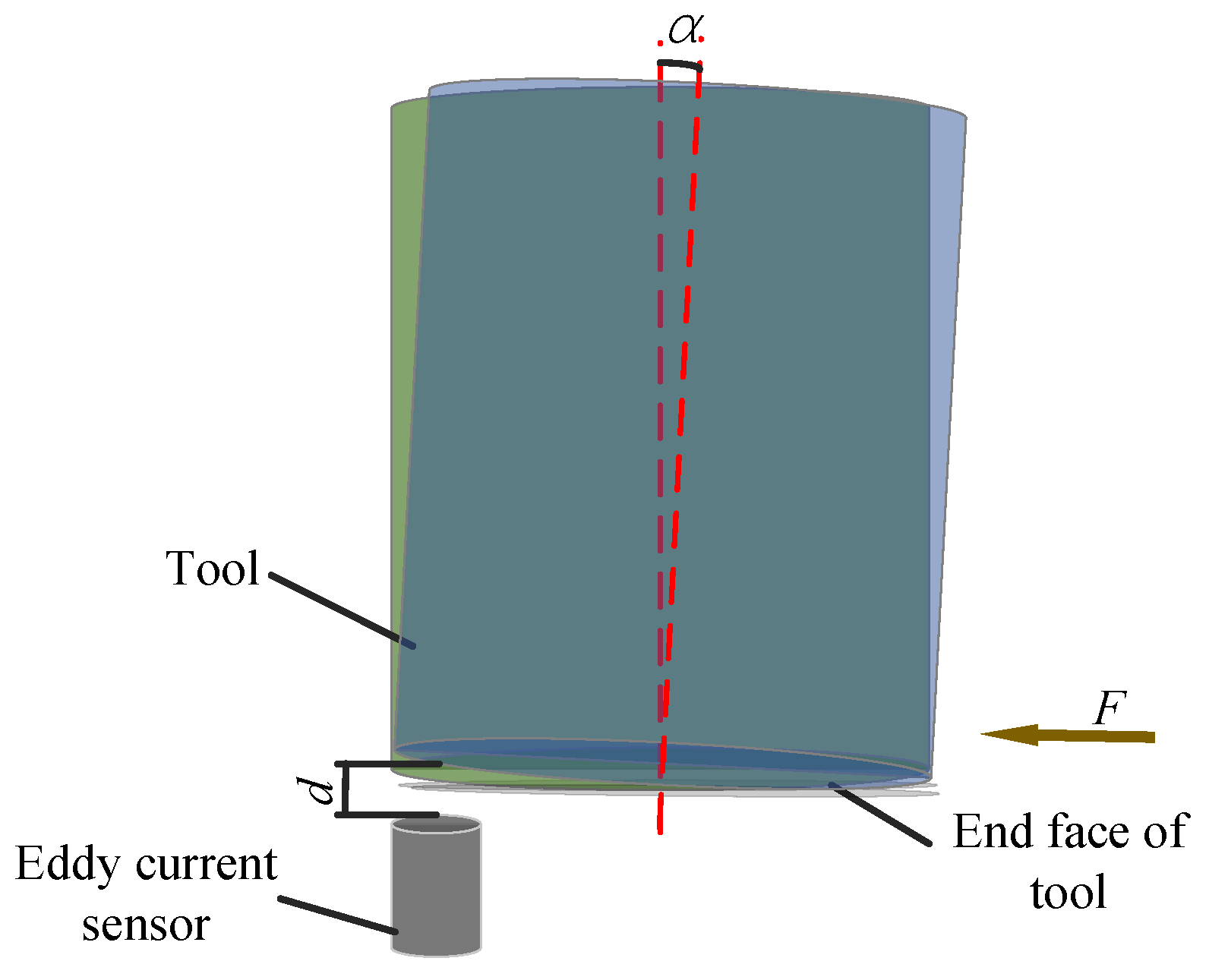
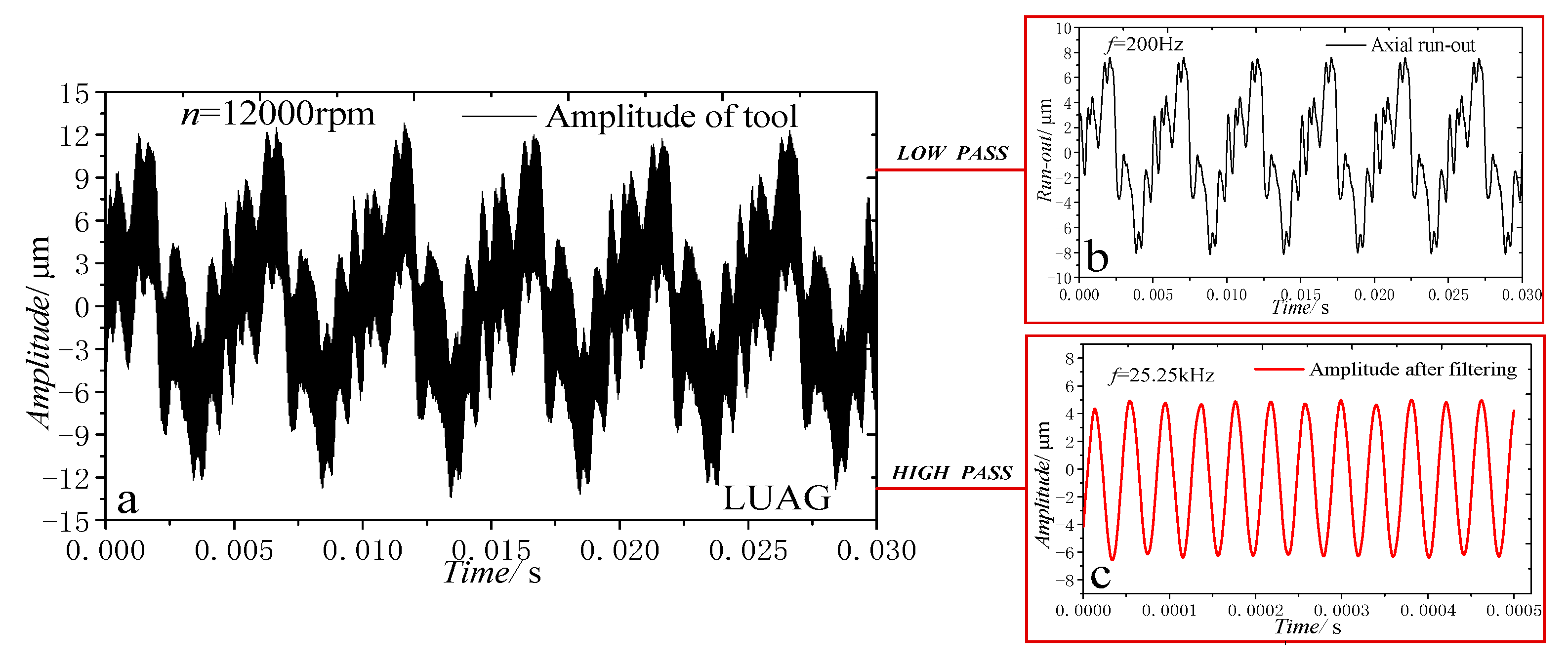

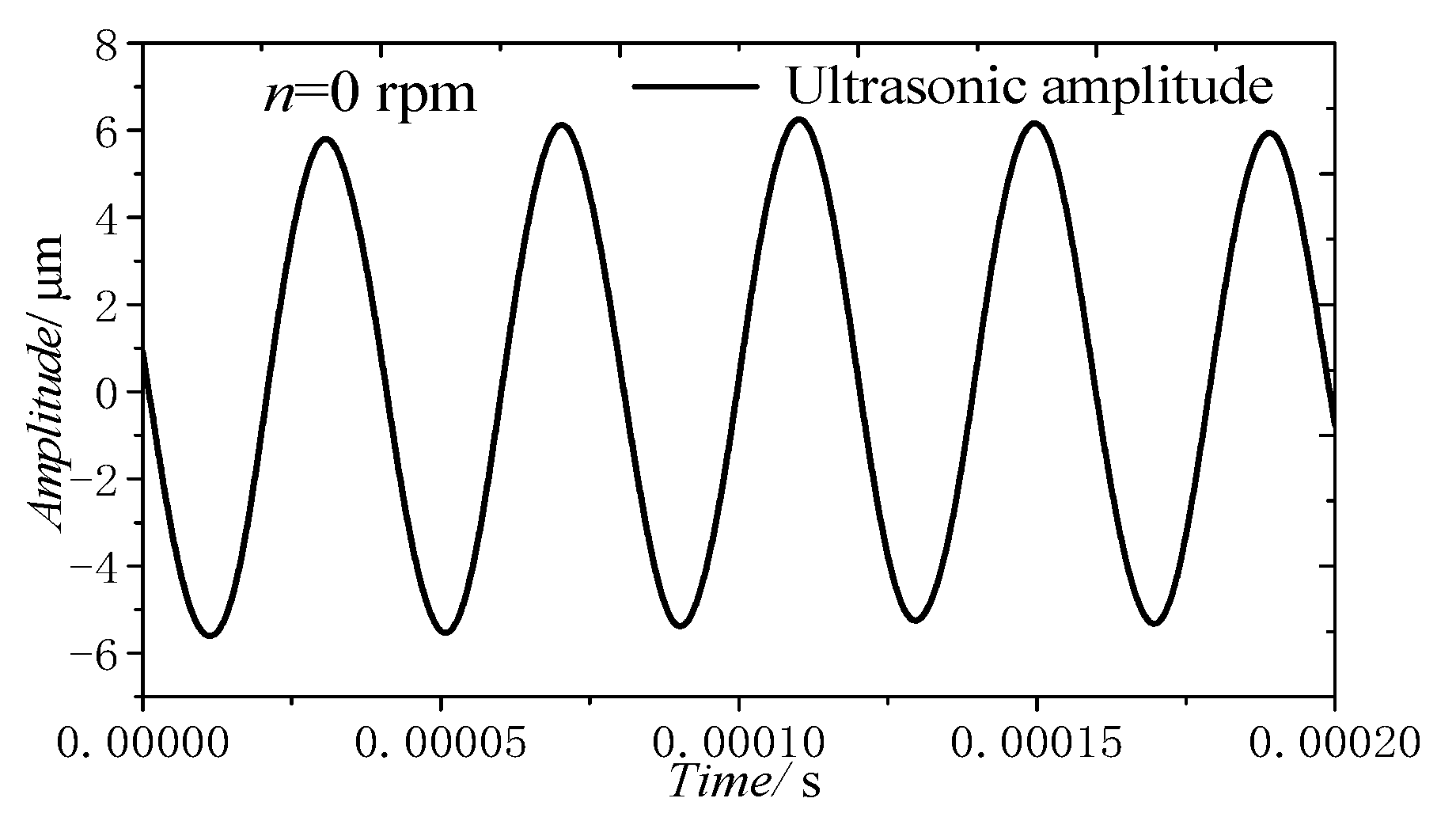
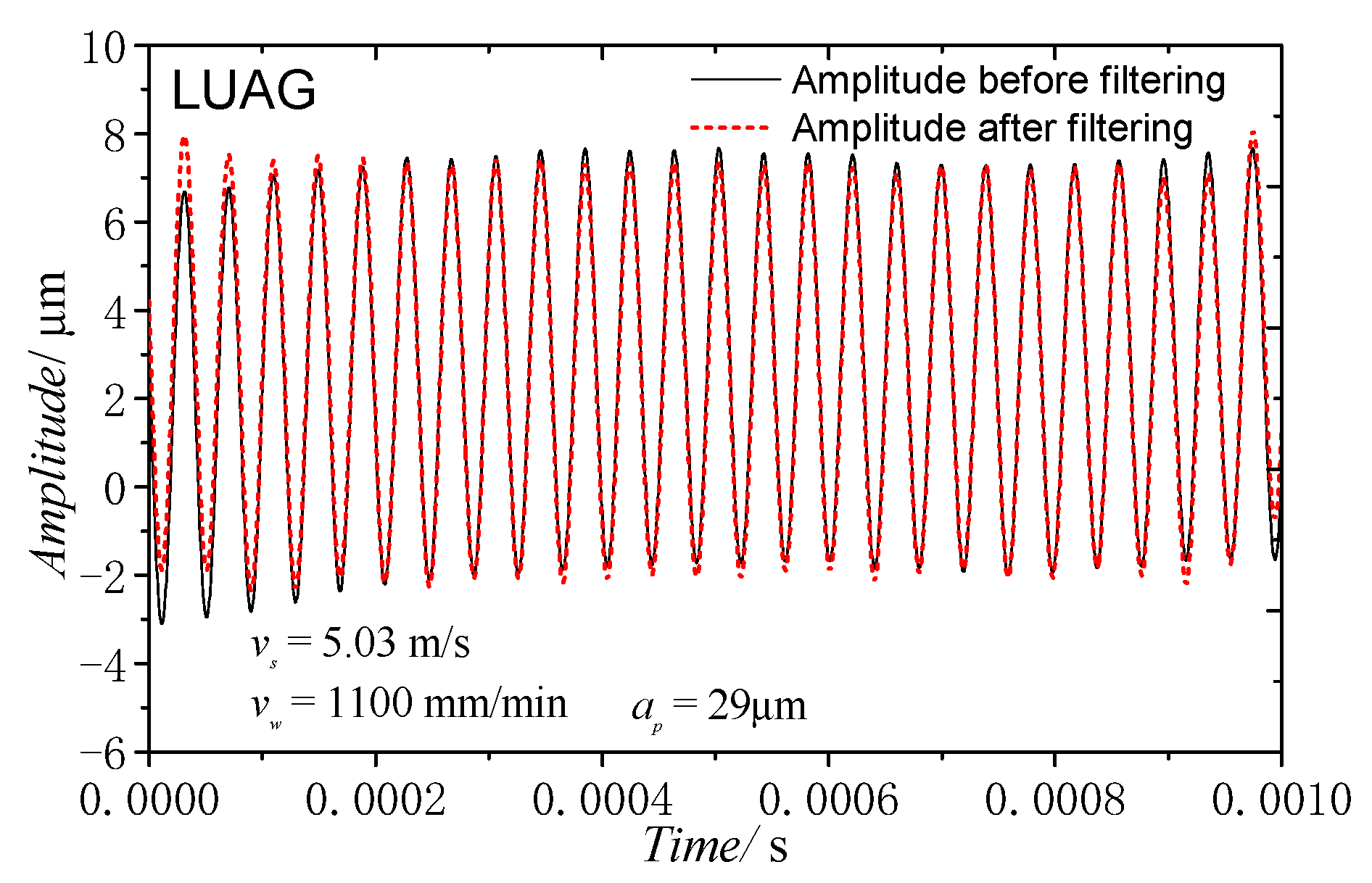
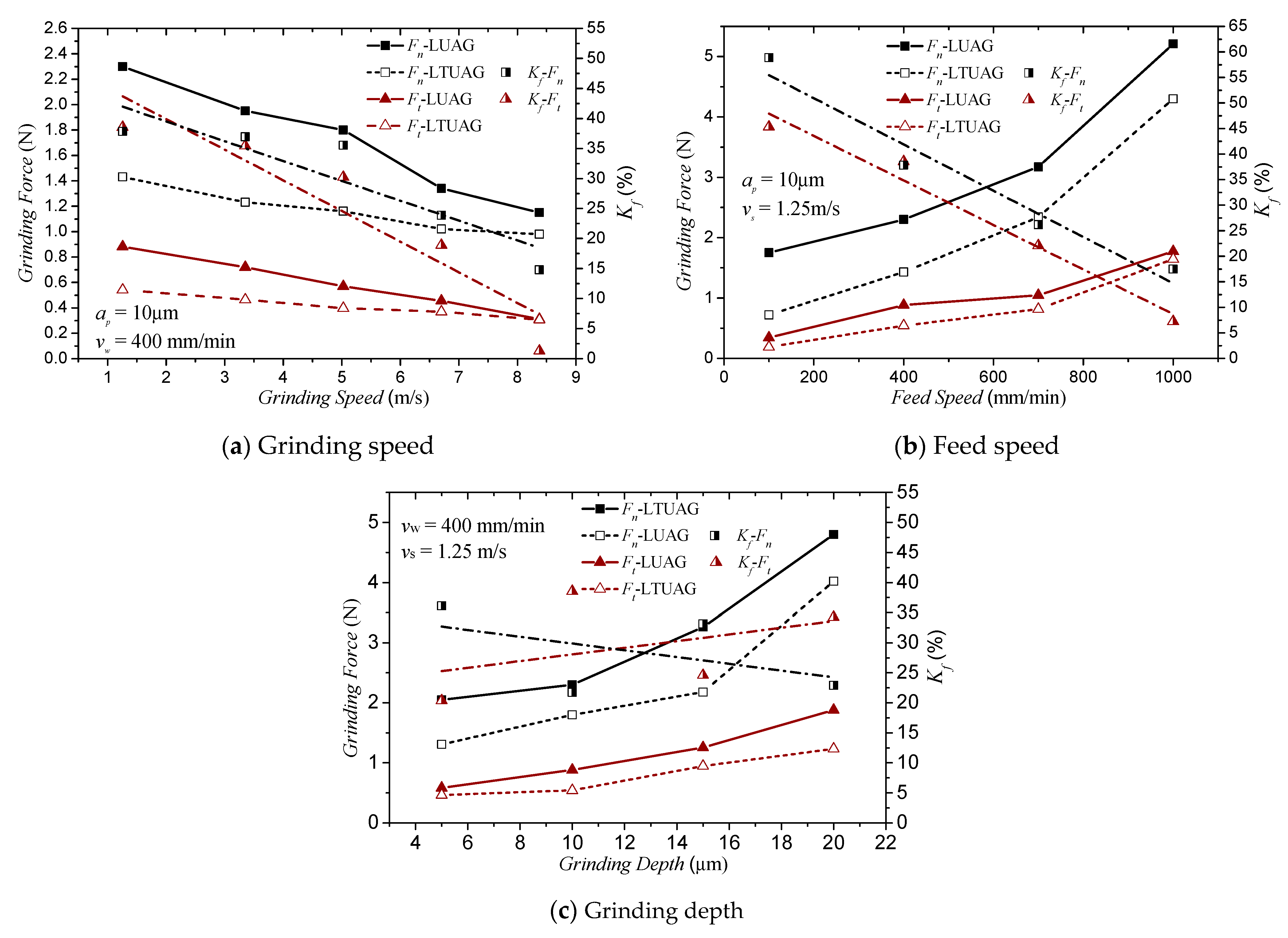
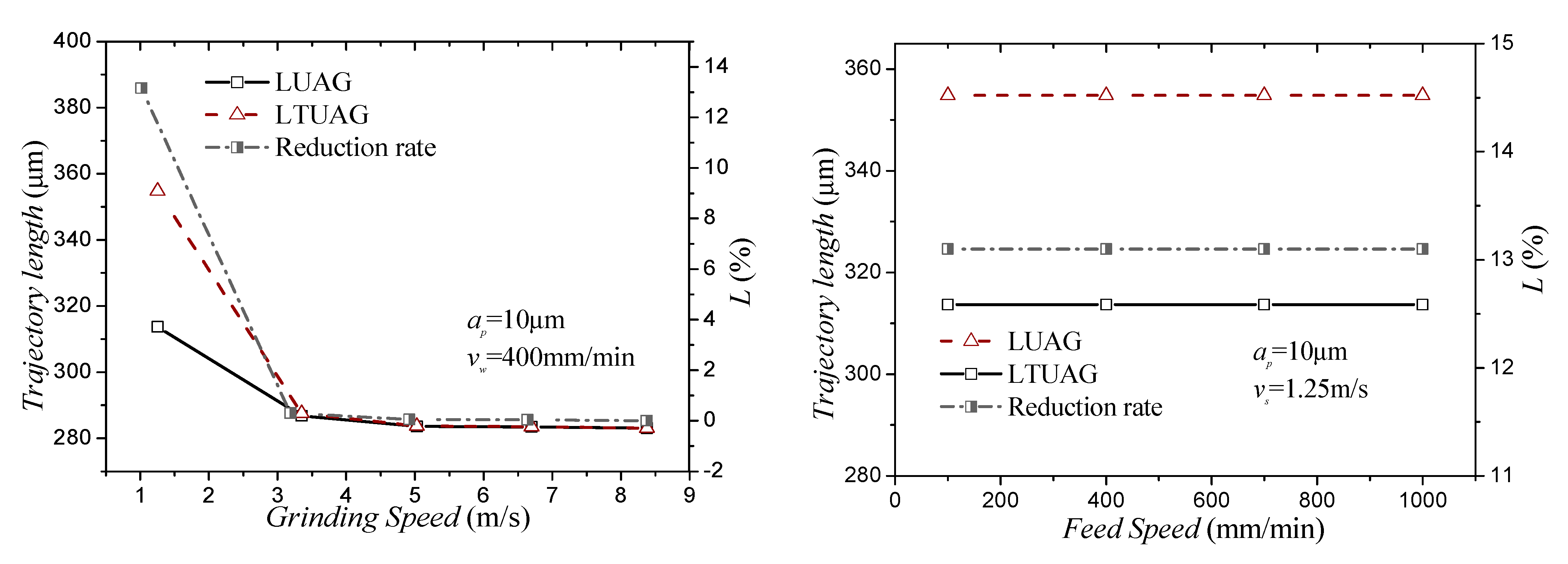
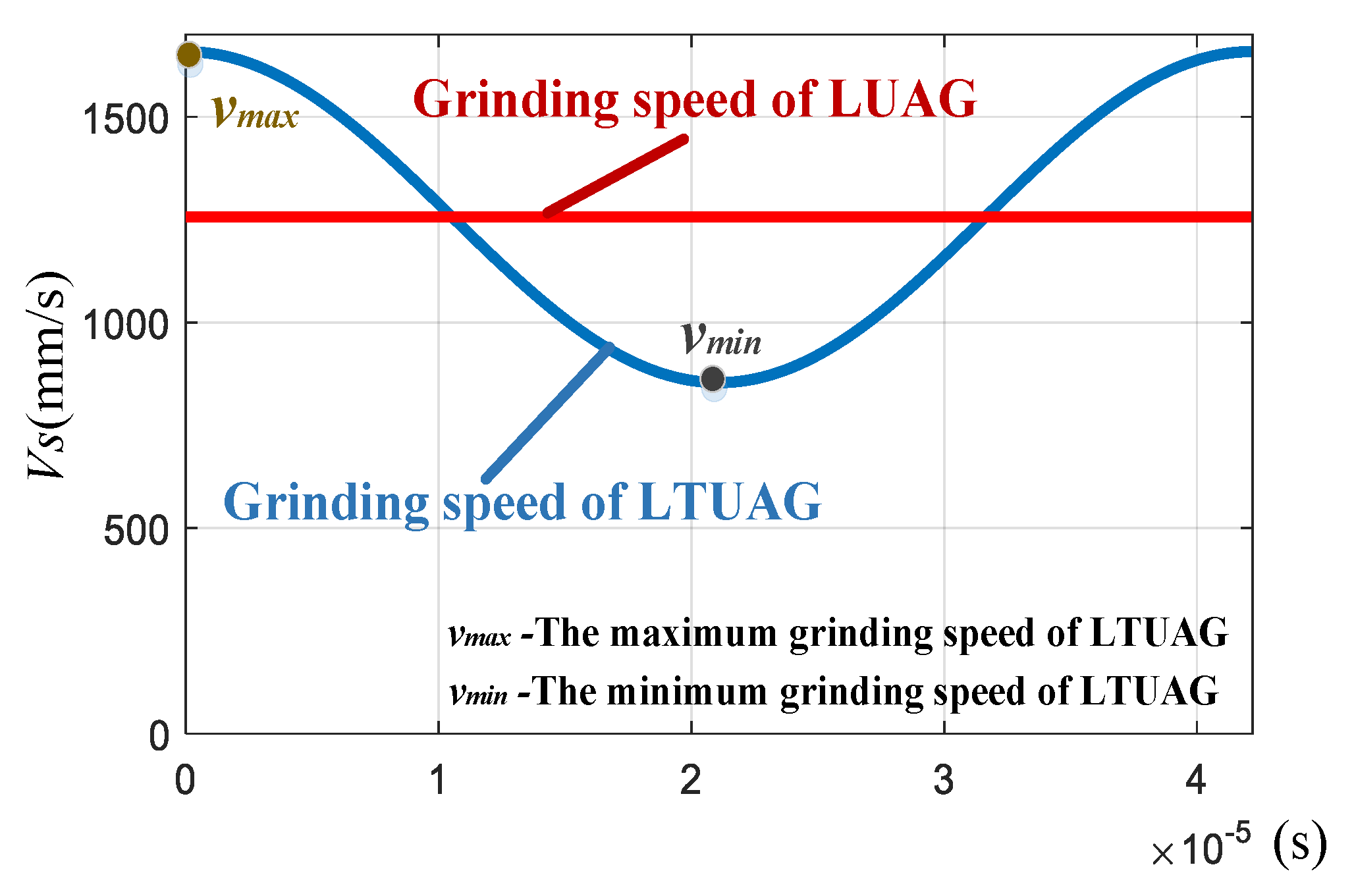
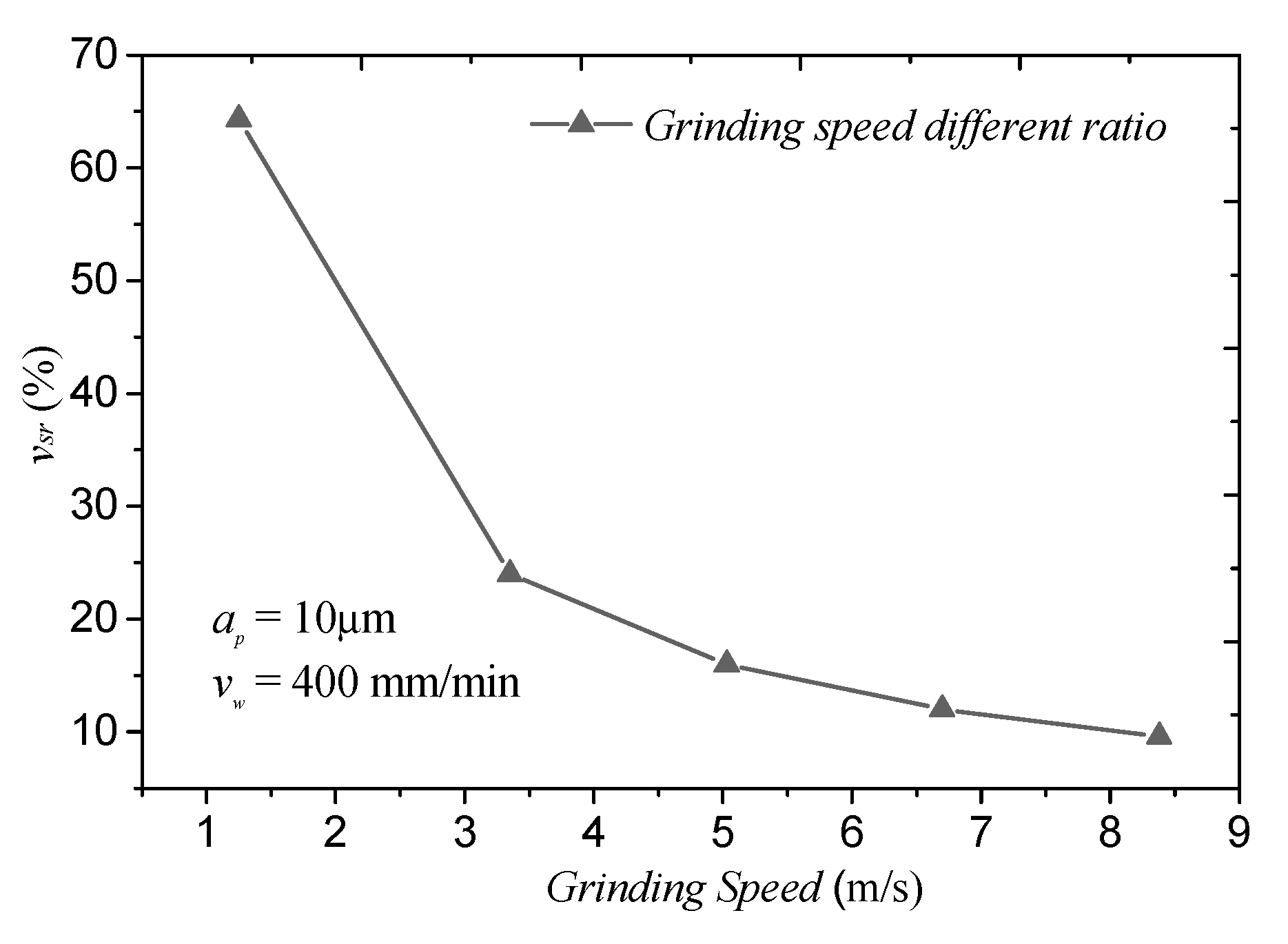


| Properties | Value | Unit |
|---|---|---|
| SiC content | ≥98 | % |
| Density | 3.15 | g/cm3 |
| Fracture toughness | 3.2 | MPa·m1/2 |
| Vickers hardness | 28 | GPa |
| Young’s modulus | 4.1 × 105 | MPa |
| Parameters | Value |
|---|---|
| Grinding speed vs/(m/s) | 1.25, 3.35, 5.03, 6.7, 8.38 |
| Feed speed vw/(mm/min) | 100, 400, 700, 1000 |
| Grinding depth ap (μm) | 5, 10, 15, 20 |
| Radial depth of cut ae (mm) | 2 |
| Parameters | Value |
|---|---|
| Overhang length of the tool (mm) | LUAG: 26 LTUAG: 22 |
| Frequency (kHz) | 24.4 |
| Actual amplitude (μm) | LUAG: 6 (AL) LTUAG: 6 (AL), 2.8 (AT) |
Publisher’s Note: MDPI stays neutral with regard to jurisdictional claims in published maps and institutional affiliations. |
© 2021 by the authors. Licensee MDPI, Basel, Switzerland. This article is an open access article distributed under the terms and conditions of the Creative Commons Attribution (CC BY) license (http://creativecommons.org/licenses/by/4.0/).
Share and Cite
Chen, Y.; Su, H.; He, J.; Qian, N.; Gu, J.; Xu, J.; Ding, K. The Effect of Torsional Vibration in Longitudinal–Torsional Coupled Ultrasonic Vibration-Assisted Grinding of Silicon Carbide Ceramics. Materials 2021, 14, 688. https://doi.org/10.3390/ma14030688
Chen Y, Su H, He J, Qian N, Gu J, Xu J, Ding K. The Effect of Torsional Vibration in Longitudinal–Torsional Coupled Ultrasonic Vibration-Assisted Grinding of Silicon Carbide Ceramics. Materials. 2021; 14(3):688. https://doi.org/10.3390/ma14030688
Chicago/Turabian StyleChen, Yurong, Honghua Su, Jingyuan He, Ning Qian, Jiaqing Gu, Jiuhua Xu, and Kai Ding. 2021. "The Effect of Torsional Vibration in Longitudinal–Torsional Coupled Ultrasonic Vibration-Assisted Grinding of Silicon Carbide Ceramics" Materials 14, no. 3: 688. https://doi.org/10.3390/ma14030688
APA StyleChen, Y., Su, H., He, J., Qian, N., Gu, J., Xu, J., & Ding, K. (2021). The Effect of Torsional Vibration in Longitudinal–Torsional Coupled Ultrasonic Vibration-Assisted Grinding of Silicon Carbide Ceramics. Materials, 14(3), 688. https://doi.org/10.3390/ma14030688






